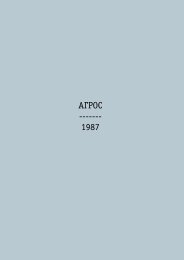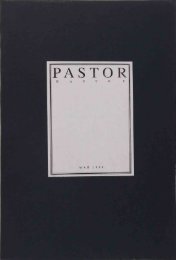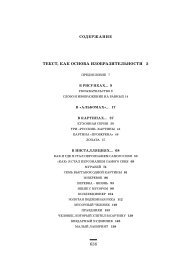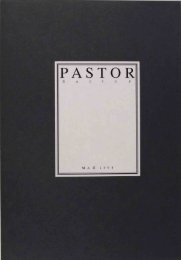А. Монастырский, Н. Панитков, И. Макаревич, Е. Елагина, С ...
А. Монастырский, Н. Панитков, И. Макаревич, Е. Елагина, С ...
А. Монастырский, Н. Панитков, И. Макаревич, Е. Елагина, С ...
You also want an ePaper? Increase the reach of your titles
YUMPU automatically turns print PDFs into web optimized ePapers that Google loves.
tradition, into which the aesthetic praxis of CA falls Or does the application of the strange device of<br />
reducing the portrait in size draw attention to the ambivalent relationship to this tradition From my<br />
point of the view, this performance demonstrates the CA‘s self-image as an aesthetic praxis that does<br />
not only create a situation for aesthetic perception, but connects this situation with the process of<br />
reflection, relating the direct experience of ―now and here‖ with general systemic philosophical<br />
notions. As I see it, playing on spatio-temporal categories, perception, and cognition have a central<br />
meaning to the activities of CA. In this connection, one could ask: why didn‘t you hang up a portrait<br />
of Immanuel Kant Maybe because the case of Heidegger gives rise to a more provocatively<br />
ambivalent relationship to the philosophical tradition<br />
If the rational system of Kant is still centered on the subjective capacities for perception and<br />
cognition, then in Heidegger, we encounter more complex interconnections between the subject and<br />
the object, which form the structure of aesthetic experience. Moreover, subject and object can<br />
potentially trade places. But here the most provocative moment probably consists in the fact that the<br />
portrait of Heidegger (and especially his canonic portrait with oak-leaves on his jacket lapels) refers<br />
to the realization of philosophical praxis in the political context of fascist ideology. To talk about the<br />
connection between aesthetic and philosophico-political contexts in more detail, it makes sense to<br />
examine the use of notions such as spatiality, space, and place in Heidegger. For action art, it is<br />
important that Heidegger develops a phenomenological understanding of space – in counterbalance to<br />
abstract, mathematical space – through the experience of the Lebenswelt (―life-world‖). This gives<br />
rise to a different view of the surrounding world. The installation of things creates an aesthetic<br />
experience of place that I view as something ambivalent. On the one hand, Heidegger developed the<br />
notion of ―ground/homeland‖ as the fundamental place of a people‘s existence, which fascist ideology<br />
later appropriated. On the other hand, if one follows Heidegger‘s line of thinking, the installation of<br />
things means that they are no longer perceived as such (as in Kant); instead, they displace the gaze<br />
onto the surrounding world. The boundaries of the artwork become blurred, giving rise to a new<br />
experience of openness.<br />
A.M.: We did actually use Kant – in the form of an unusually big (fat) book – in the action 625-520,<br />
the first action of the forest cycle, whose last action is actually Slogan-2003, which use the unusually<br />
small portrait of Heidegger. What is interesting in both cases is the distortion and hypertrophy of size,<br />
not only as a stylistic trait of romanticism, but as a certain pathology of discourse, which this plastical<br />
abnormality actually refers to. What we have here is a diagnose of CA: textual distension along with<br />
visual insuffiency and squalid design. But you could also apply this diagnose to the Russian<br />
logocentric mentality as a whole. The maniacal commitment to logocentrism in Russia (which I<br />
emphasize by carrying on the discourse of CA and opposing it to Western anthropocentrism) is, in<br />
fact, the ―philosophical‖ basis for the total disregard for the human personality in Russia at all stages<br />
of its history, including modernity. In Russia (and in the aesthetics of CA, to my sincere regret and<br />
shame), the human being is an abstract structural element, dangling somewhere along the ―edges‖, a<br />
certain instrument of a supposedly ―scientific‖ exploration of something ―common‖, of ―everything‖,<br />
etc. This is why human life has no value here, in essence.<br />
Getting back to the Heidegger portrait in the action Slogan-2003, one should consider the<br />
commonalities between the Action with Hours and this slogan. In fact, a string was drawn through the<br />
forest from the tape recorder from the Action with Hours to the portrait of Heidegger. The tape<br />
recorder reproduced texts of Soviet polar explorers of the 1930s, which segued into Heidegger‘s text<br />
on extension. So what we have here are the different sides of temporal and totalitarian commonality<br />
through the juxtaposition of Soviet polar explorers and Heidegger. Here, it is as if Heidegger emerges<br />
out these polar explorers just like Russian literature emerges from Gogol‘s overcoat. Although, of<br />
course, the structure of this interrelation is more complex. But this aspect is also present. Excessive<br />
acuity toward existentialism leads to totalitarianism. Polar explorers and hermits are very closely<br />
related. Soviet polar explorers are state hermits and present an interesting statist form of<br />
existentialism. Polar explorers are very religious and ascetic somehow. And, of course, so is<br />
Heidegger. Befitting of his religious essence, he deserves a ―portrait‖ (―icon‖) and ―speech‖<br />
(―preaching‖) (Action with Hours). But the figure of Kant is the complete opposite in this sense; he is<br />
critical, which is why he was given a ―book‖ (625-520), though it was inflated to an abnormal size,<br />
apparently because, in fact, it contained his early, pre-critical texts. As far as CA is concerned, it<br />
seems to me that we have reached a post-critical period, especially in our last Slogan-2005. And here<br />
it is important not to lose a sense of irony; otherwise, it could easily lead to some new mania.

















